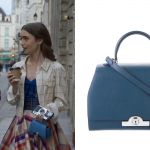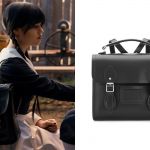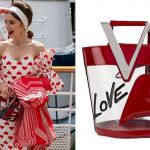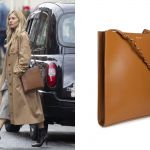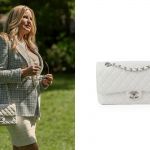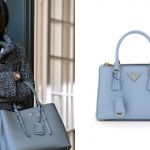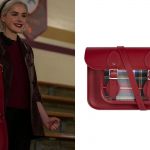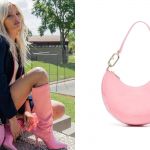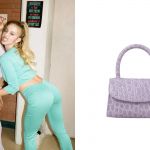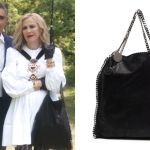
The importance of bags in TV series
Tell me which model you wear and I'll tell you which character you are
December 7th, 2022
Clothes can shape a character on screen. Years of films and TV series have taught this to even the less cinephile among us. The colors, the fit, the texture, the styling often speak to us more than the most passionate dialogue. A good costume designer knows this. And a viewer learns it. It is enough to know how to listen. All it takes is to look at the details, seemingly insignificant things like the turn of a sleeve, the brand of a skirt, the shape of a clothes peg in your hair or the way you hold your handbag in your hands to open up a conversation between us and those in front of us. What would Holly Golightly be without her little black dress and sparkling jewelry, Annie Hall without her tomboy outfit, Elle Woods without her pink outfits or Mary Poppins without her huge handbag from which all sorts of things come out? Quite simply, they would be someone else.
Let's take Wednesday Addams. She doesn't need to talk. Nor does she have to bat her eyelashes. You only have to look at her to know her. The perpetually pouty lips, the sharp braids, the outfits that mix gothic elements, Dark Academia influences and Gen Z vibes strictly in black and white. They tell of the most popular outcast ever, the little girl who loved to guillotine her dolls and torture her younger brother, the one who makes emotional detachment her credo and only allows herself to smile at the sight of Uncle Fester. An outcast who flaunts sadism, "doesn't let herself be influenced by others and always remains herself", but whom the Netflix format sees as a kind of feminist heroine impassive to disappointments, betrayals and loneliness. Tim Burton's Wednesday, is an outsider, but not too much. She is stiff and aloof, but softens as the episodes flow and her stay at the Nevermore Academy continues. And the clothes are enough to tell, or better still, the accessories. The Cambridge Satchel & Co backpack that she always wears on her shoulders (sometimes she alternates it with a shoulder bag by the same brand) with its decisive, square lines, slightly cracked by wear. The exact opposite of the model worn by her roommate. Enid Sinclair is an explosion of colour and warmth that also runs through her tricot jumpers and her furry backpack (an allusion to her being a werewolf?) and pink, the Mini Alba Heart Backpack by Skinnydip.
Bags are a powerful vehicle of meaning. Born as a utilitarian and unisex item to be worn hanging from the neck or around the waist, they soon broke free from the body to become an extension of our personality, capable of telling our tastes, revealing our social affiliation and guarding our secrets. They indicated privileged status long before Jane Birkin spilled her straw bag on a flight next to Jean-Louis Dumas, CEO of Hermès, giving birth to one of the most desired fashion objects ever. And they still do to this day, but it's not the only thing they talk about. Sigmund Freud, for example, saw the hollow shape and the function of enclosing something as a symbolic representation of female genitalia and the maternal womb; an extension of female sexuality in a broad sense. To read their storytelling without bothering the father of psychoanalysis, one need only press play and observe one of the many protagonists of TV series.
A handbag can convey and legitimize power, status. Better if it is Prada. And we are not alluding to Miranda Presley, but to girl bosses who stand out in a male-dominated environment such as Jessica Pearson of Suits or Scandal's Olivia Pope, who for all seven seasons of the series wore nothing but a minimal, authoritative and very precious model created by Miuccia Prada. Prestige, social position and, above all, money she no longer has Moira Rose of Schitt's Creek, the mother of a wealthy family swindled by the business manager who finds herself forced to shelter penniless in a remote village and clinging to her outfits and designer handbags from a few seasons ago such as Falabella by Stella McCartney or the Mini Luggage by Celine. The one who is a breath away from having everything she wants (all she lacks is a certain, slightly creepy house) and doesn't see herself flaunting it is the cloyingly friendly Karen Calhoun of The Watcher who opts for Chanel Classic Double Flap 26, in pink and white, in a perfect match with her rich and famous wannabe personality. A choice in stark contrast to the understatement suggested by the accessories of the other female protagonist of the Netflix series, Nora Brannock, with the Celine Medium Trifold Bag in a neutral tone on her arm. A line of bags, but also of conduct (minimalist, almost restrained) reminiscent of that of Sophie Whitehouse in Anatomy of a Scandal (if you're looking for a reference for winter, her wardrobe is everything to copy) with her Jil Sander Medium Tangle and Loewe Balloon. Colour, original shapes, mini sizes and brands that are often more affordable (but not always, see a certain American moving to Paris for a new job) characterize the looks and bags of teenagers and 20-somethings told by the TV series. Here, emotionality and the character's personal journey too often give way to mere product placement or fashionista trends. Some examples? The girls of Elite and Euphoria sport mini shoulder bags and handbags as luscious and cute as bonbons, from Maddy Perez's lilac By Far to Ari Blanco's mini Top Handle Furla 1927. The real queen when it comes to eccentric handbags is Emily Cooper of Emily in Paris, she changes so many that her style seems as out of focus and bewildered as she is in love and in her new French adventure: Jelly Snapshot by Marc Jacobs, Knit bag by Longchamp, Trifolio Bag by Ferragamo, Cleo by Prada, lots of Chanel, but also Dolce & Gabbana, Christian Louboutin, Mark Cross and many more.

























.webp)










































.jpg)


